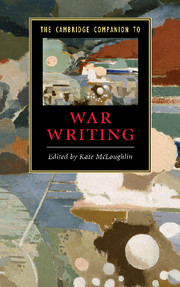Book contents
- Frontmatter
- Introduction
- Part I Themes
- Part II Influences
- Part III Poetics
- 8 Medieval warfare
- 9 Early modern war writing and the British Civil Wars
- 10 The eighteenth century and the romantics on war
- 11 American Revolutionary War writing
- 12 The Victorians and war
- 13 The American Civil War
- 14 The First World War: British writing
- 15 The First World War: American writing
- 16 The Spanish Civil War
- 17 The Second World War: British writing
- 18 The Second World War: American writing
- 19 American writing of the wars in Korea and Vietnam
- 20 The Cold War and the “war on terror”
- Index
14 - The First World War: British writing
from Part III - Poetics
Published online by Cambridge University Press: 28 January 2010
- Frontmatter
- Introduction
- Part I Themes
- Part II Influences
- Part III Poetics
- 8 Medieval warfare
- 9 Early modern war writing and the British Civil Wars
- 10 The eighteenth century and the romantics on war
- 11 American Revolutionary War writing
- 12 The Victorians and war
- 13 The American Civil War
- 14 The First World War: British writing
- 15 The First World War: American writing
- 16 The Spanish Civil War
- 17 The Second World War: British writing
- 18 The Second World War: American writing
- 19 American writing of the wars in Korea and Vietnam
- 20 The Cold War and the “war on terror”
- Index
Summary
Soldiers and civilians
In May 1917, Virginia Woolf published a review in the Times Literary Supplement of The Old Huntsman, Siegfried Sassoon's first collection of war poems. Sassoon was to become one of the most famous of the British First World War poets, and Woolf was among the first to recognize the importance of his work. No other poet, she writes, has managed to convey so strongly what is “sordid and horrible” about the war. Many others are writing about the conflict, but Sassoon produces “a new shock of surprise” in his readers. “Yes,” writes Woolf, we find ourselves saying, “this is going on; and we are sitting here watching it.” She describes the “loathing” and “hatred” at work in Sassoon's poetry (a quality some readers at the time and since have criticized as too obvious) and speculates that it shocks readers into thinking about their role as spectators to the sufferings of war, producing “an uneasy desire to leave our place in the audience.” In this, Sassoon's poetry is “realism of the right, of the poetic kind.”
Woolf's modest article shrewdly notes two areas that are crucial to an understanding of British writings of the First World War (1914-18). Firstly, it was in literature that readers at the time could learn something of what was really happening (“this is going on”).
- Type
- Chapter
- Information
- The Cambridge Companion to War Writing , pp. 160 - 174Publisher: Cambridge University PressPrint publication year: 2009
- 1
- Cited by

